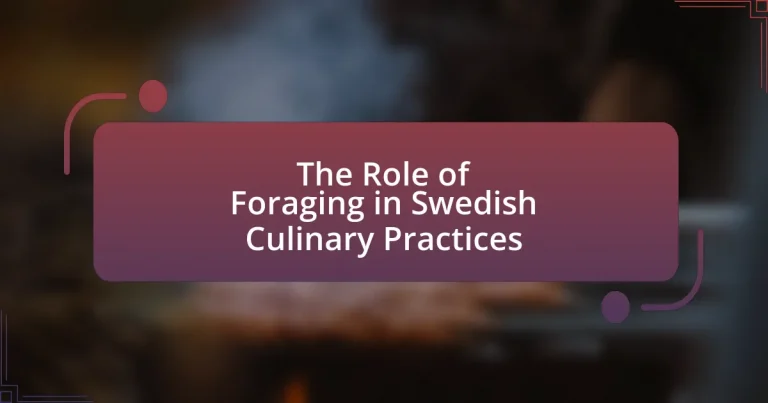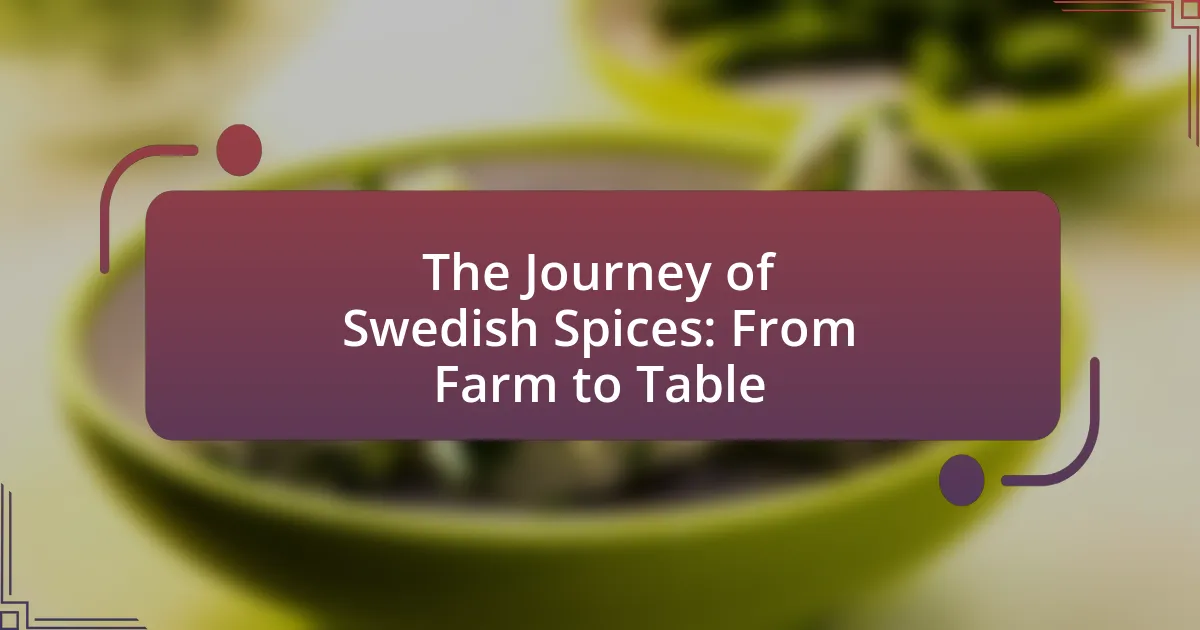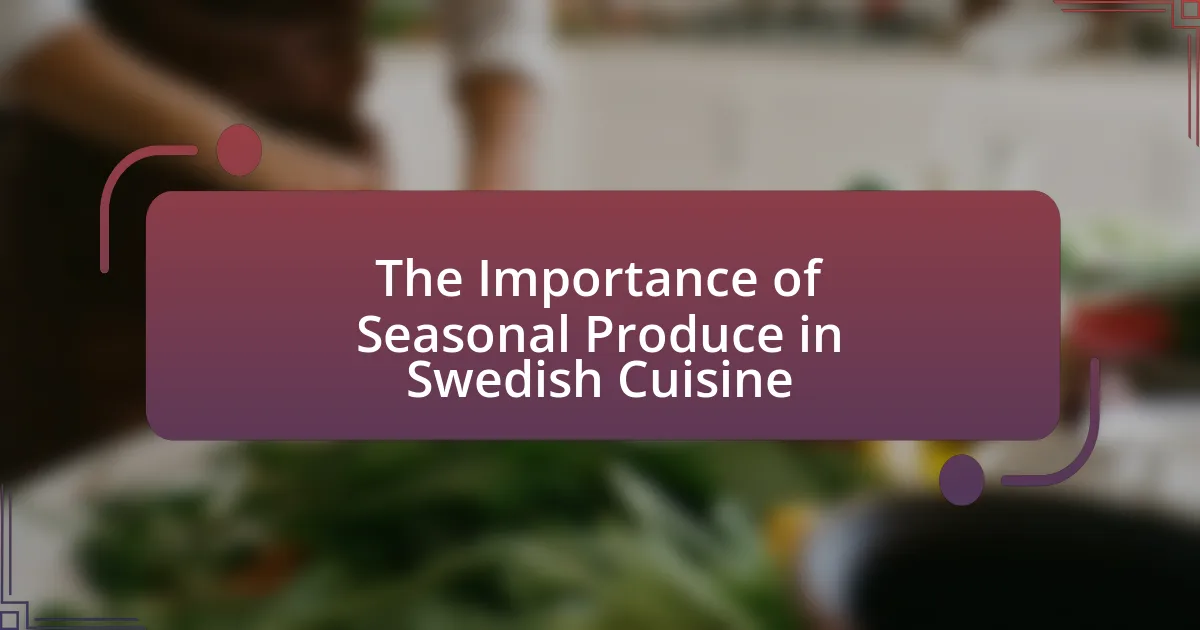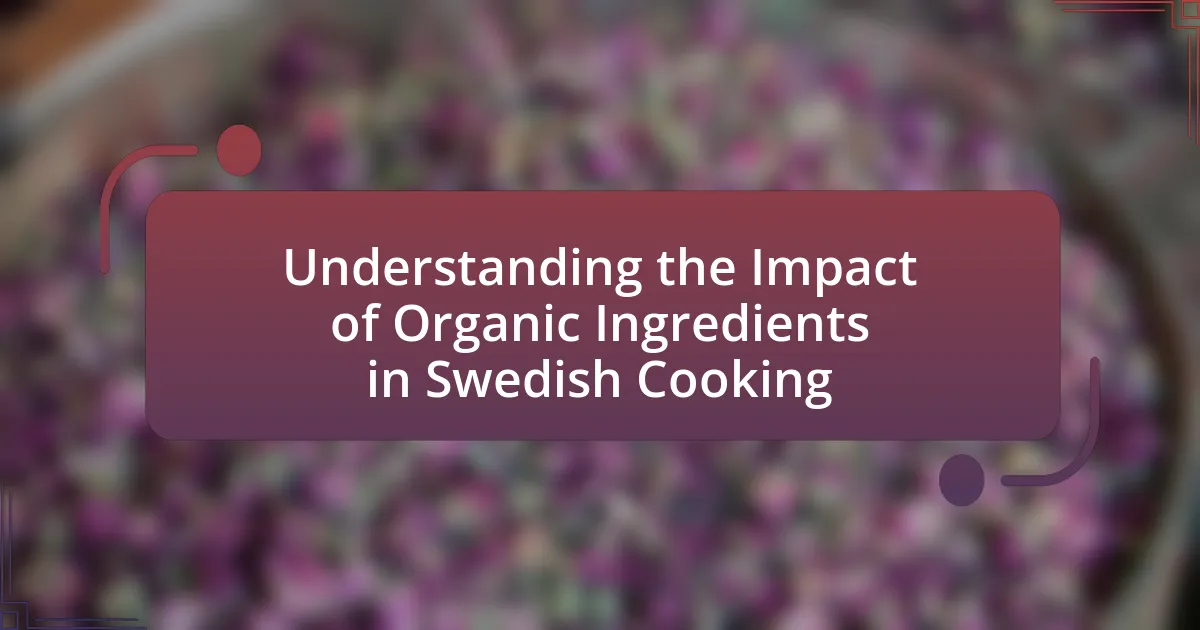Foraging is a vital aspect of Swedish culinary practices, deeply embedded in the country’s cultural heritage. It provides access to a variety of wild ingredients, such as mushrooms, berries, and herbs, which enhance traditional dishes and promote sustainability. The article explores the historical roots of foraging in Sweden, its influence on modern cuisine, and the types of ingredients commonly foraged. It also addresses the cultural attitudes that shape foraging practices, the importance of sustainability, and the challenges faced by foragers today, including legal restrictions and environmental changes. Additionally, best practices for sustainable foraging and tips for beginners are discussed, highlighting the significance of this practice in preserving biodiversity and reducing food waste.

What is the Role of Foraging in Swedish Culinary Practices?
Foraging plays a significant role in Swedish culinary practices by providing access to a diverse range of wild ingredients that enhance traditional dishes. This practice is deeply rooted in Sweden’s cultural heritage, where seasonal foraging of mushrooms, berries, and herbs is common. For example, the Swedish tradition of “plocka svamp” (mushroom picking) not only contributes to the local economy but also promotes sustainability and a connection to nature. Additionally, the use of foraged ingredients in modern Swedish cuisine reflects a growing trend towards local and organic food sourcing, aligning with the principles of New Nordic Cuisine, which emphasizes freshness and locality.
How has foraging influenced traditional Swedish cuisine?
Foraging has significantly influenced traditional Swedish cuisine by integrating wild ingredients into everyday cooking. This practice has deep historical roots, as Sweden’s diverse ecosystems provide a variety of edible plants, mushrooms, and berries, which have been harvested for centuries. For example, ingredients like lingonberries, cloudberries, and various wild mushrooms are staples in Swedish dishes, reflecting the seasonal availability of foraged foods. The tradition of foraging not only enhances the flavor profiles of Swedish cuisine but also promotes sustainability and a connection to nature, as many Swedes continue to gather wild foods as part of their culinary heritage.
What are the historical roots of foraging in Sweden?
The historical roots of foraging in Sweden date back to prehistoric times when hunter-gatherer societies relied on wild plants and animals for sustenance. Archaeological evidence indicates that foraging was a fundamental aspect of life in Sweden, with ancient populations utilizing a diverse range of edible flora and fauna, including berries, mushrooms, and fish. This practice continued through the Viking Age, where foraging complemented agriculture and trade, as documented in historical texts and sagas that highlight the importance of wild food sources. The enduring tradition of foraging in Sweden is reflected in contemporary culinary practices, where seasonal wild ingredients are celebrated and integrated into modern Swedish cuisine.
How do cultural attitudes towards foraging shape culinary practices?
Cultural attitudes towards foraging significantly shape culinary practices by influencing the acceptance and integration of wild ingredients into traditional dishes. In Sweden, for example, a strong cultural appreciation for nature and sustainability fosters a culinary landscape that embraces foraged foods such as mushrooms, berries, and herbs. This is evident in the popularity of dishes that highlight these ingredients, reflecting a deep-rooted respect for local ecosystems and seasonal availability. Furthermore, the Swedish tradition of “allemansrätten,” or the right to roam, encourages foraging, thereby reinforcing its role in culinary practices and promoting a connection between food, culture, and the environment.
What types of ingredients are commonly foraged in Sweden?
Commonly foraged ingredients in Sweden include mushrooms, berries, and wild herbs. Specifically, popular mushrooms such as chanterelles and porcini are sought after during the autumn months, while berries like lingonberries, blueberries, and cloudberries are harvested in late summer to early autumn. Additionally, wild herbs such as nettles and wild garlic are foraged in spring. The practice of foraging is deeply rooted in Swedish culture, with a long tradition of utilizing these natural resources for culinary purposes, reflecting the country’s rich biodiversity and seasonal availability of ingredients.
Which wild plants are most popular among Swedish foragers?
The most popular wild plants among Swedish foragers include bilberries, lingonberries, chanterelles, and wild garlic. Bilberries are favored for their sweet flavor and high antioxidant content, while lingonberries are commonly used in traditional dishes and jams. Chanterelles are sought after for their culinary versatility and rich taste, and wild garlic is appreciated for its distinctive flavor and health benefits. These plants are integral to Swedish culinary practices, reflecting the country’s deep-rooted foraging culture.
How do foraged ingredients differ from cultivated ones in flavor and nutrition?
Foraged ingredients typically exhibit more complex flavors and higher nutritional value compared to cultivated ones. Foraged plants often grow in diverse, natural environments, which can enhance their flavor profiles due to varied soil conditions and exposure to natural elements. Research indicates that wild foods can contain higher levels of vitamins, minerals, and antioxidants; for example, a study published in the Journal of Food Composition and Analysis found that wild greens like dandelion and nettle have significantly higher vitamin C and iron content than their cultivated counterparts. This difference in flavor and nutrition is attributed to the plants’ adaptation to their ecosystems, leading to a richer taste and greater nutrient density.
Why is foraging important for sustainability in Swedish cooking?
Foraging is important for sustainability in Swedish cooking because it promotes the use of local, seasonal ingredients that reduce environmental impact. By sourcing food from the wild, Swedish chefs and home cooks minimize reliance on industrial agriculture, which often involves high carbon emissions and resource depletion. Foraging also encourages biodiversity, as it involves harvesting a variety of plants and fungi, thus supporting ecosystem health. Furthermore, traditional foraging practices in Sweden, such as gathering berries and mushrooms, are deeply rooted in cultural heritage, fostering a connection between people and their natural environment. This practice not only sustains local food systems but also enhances culinary creativity and appreciation for native flavors.
How does foraging contribute to biodiversity in Swedish ecosystems?
Foraging contributes to biodiversity in Swedish ecosystems by promoting the growth and survival of various plant and animal species. This practice encourages the sustainable use of wild resources, which helps maintain genetic diversity within populations. For example, foragers often collect a wide range of edible plants, fungi, and berries, which can lead to the preservation of native species that might otherwise decline due to habitat loss or agricultural practices. Research indicates that areas with active foraging show higher levels of species richness and ecosystem resilience, as diverse foraging activities support a variety of ecological interactions and nutrient cycles.
What role does foraging play in reducing food waste?
Foraging plays a significant role in reducing food waste by utilizing wild, edible plants and fungi that would otherwise go unharvested. This practice encourages the consumption of local, seasonal ingredients, which minimizes reliance on mass-produced food that often contributes to waste through overproduction and spoilage. Research indicates that foraging can lead to a more sustainable food system; for example, a study published in the journal “Sustainability” highlights that foraging not only provides fresh food but also promotes biodiversity and reduces the carbon footprint associated with food transportation. By integrating foraged foods into culinary practices, individuals can effectively decrease food waste while enhancing their diet with diverse flavors and nutrients.
How does modern Swedish cuisine incorporate foraged ingredients?
Modern Swedish cuisine incorporates foraged ingredients by emphasizing seasonal and local produce, which includes wild herbs, mushrooms, berries, and roots. Chefs in Sweden often utilize foraged items to enhance flavors and create unique dishes that reflect the natural landscape. For example, ingredients like chanterelle mushrooms and cloudberries are commonly featured in contemporary recipes, showcasing the connection between the cuisine and the surrounding environment. This practice not only promotes sustainability but also honors traditional culinary methods, as foraging has been a part of Swedish culture for centuries.
What challenges do foragers face in Sweden today?
Foragers in Sweden today face several challenges, including legal restrictions, environmental changes, and competition for resources. Legal restrictions arise from regulations that limit foraging in certain areas, particularly in protected nature reserves, which can hinder access to traditional foraging sites. Environmental changes, such as climate change, affect the availability and growth patterns of wild edible plants and mushrooms, making it more difficult for foragers to find reliable sources. Additionally, increased urbanization and land development reduce natural habitats, further complicating foraging efforts. Competition from other foragers and commercial interests can also lead to overharvesting in popular areas, diminishing the sustainability of foraging practices.
How do regulations impact foraging practices in Sweden?
Regulations significantly impact foraging practices in Sweden by establishing guidelines that protect natural resources and ensure sustainable harvesting. The Swedish Right of Public Access allows individuals to forage for wild berries, mushrooms, and certain plants without permission, promoting a culture of foraging. However, regulations also restrict foraging in protected areas and specify which species can be harvested to prevent overexploitation. For instance, the Swedish Environmental Code mandates that foraging must not harm the environment or biodiversity, ensuring that practices remain sustainable. These regulations are crucial for maintaining ecological balance while allowing foraging to be a part of Swedish culinary traditions.
What are the risks associated with foraging in the wild?
The risks associated with foraging in the wild include the potential for misidentifying edible plants, which can lead to poisoning or severe allergic reactions. For example, some wild mushrooms closely resemble toxic varieties, and consuming them can result in serious health issues or even death. Additionally, foragers may encounter hazardous wildlife, such as snakes or aggressive animals, which pose physical threats. Environmental factors, such as extreme weather conditions or difficult terrain, can also lead to accidents or injuries while foraging. Furthermore, foraging in areas contaminated with pollutants can expose individuals to harmful substances, making it crucial to understand the local ecosystem and regulations regarding foraging.
What are some best practices for foraging in Sweden?
Best practices for foraging in Sweden include understanding local regulations, identifying edible species accurately, and respecting nature. Foragers should familiarize themselves with the Allemansrätten, or “Everyman’s Right,” which allows public access to nature but requires responsible behavior. Accurate identification of plants, mushrooms, and berries is crucial, as some species can be toxic; resources like field guides or local foraging groups can aid in this. Additionally, foragers should only harvest what they need, ensuring sustainability and minimal impact on ecosystems. Following these practices supports both personal safety and environmental conservation.
How can foragers ensure they are harvesting sustainably?
Foragers can ensure they are harvesting sustainably by following the principle of taking only what they need and leaving enough for the ecosystem to regenerate. This practice is supported by guidelines such as the “Rule of Thirds,” which suggests that foragers should only harvest one-third of a plant population to allow for continued growth and reproduction. Additionally, foragers should educate themselves about local species, their growth cycles, and the ecological impact of their harvesting methods, as sustainable foraging practices contribute to biodiversity and ecosystem health. Research indicates that sustainable foraging can enhance local food systems while preserving natural habitats, as seen in various studies on indigenous foraging practices that promote ecological balance.
What tips can help beginners get started with foraging in Sweden?
To get started with foraging in Sweden, beginners should first familiarize themselves with local edible plants and mushrooms by using reliable field guides or apps. This foundational knowledge is crucial, as Sweden has a diverse range of flora, including berries like lingonberries and mushrooms such as chanterelles, which are popular in Swedish cuisine. Additionally, beginners should practice sustainable foraging by only taking what they need and ensuring they leave enough for wildlife and future growth. Understanding the legal aspects of foraging is also important; in Sweden, the Allemansrätten (Everyman’s Right) allows for public access to nature, but foragers must respect private property and protected areas. Engaging with local foraging groups or workshops can provide practical experience and enhance knowledge about safe and responsible foraging practices.





